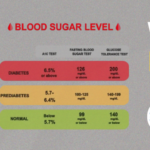What Are The Signs Of Unhealthy Eyes?
Iridology is kind of a holistic healing modality which involves analysing the iris or the coloured part of the eye in order to detect potential diseases. Iridology is the study of the patterns, colours, and other features of the iris which can reveal a lot about a person’s state of health.
According to practitioners, there are different areas in the iris and each area corresponds to the different organs and systems in the human body which enables the practitioner to detect potential weaknesses or illnesses by observing the iris.
In this article, we will discuss these signs that indicate unhealthy eyes based on Iridology. We will also explore how the signs are interpreted by Iridologists and what they might mean in regards to the health of the person.
The Basics of Iridology
The concept of Iridology is based on the fact that the eyes are considered as a reflection of the state of an individual’s health. For this reason, by looking at the colour, structure of fibres, as well as the patterns on the iris, an Iridologist can determine possible diseases. The practice involves utilising a specialised magnifying glass or camera to capture close-up pictures of the iris to detect any abnormality.
Key Signs of Unhealthy Eyes in Iridology
Colour Changes in the Iris
One of the first signs that Iridologists look for is a shift in the colour of the iris. These changes can range from slight discolorations to more pronounced pigment variations. For instance, patients with liver diseases may develop a yellowish coloration, whereas patients with kidney disease may present blue or greenish discoloration of the skin. Brown spots could also signify the build-up of toxins in the body or a problem with the digestive tract.
Dark Rings or Circles
Another sign that Iridologists claim to be associated with various diseases are those circles around the iris, known as ‘scurf rims.’ These scurf rims can be associated with inadequate blood circulation, accumulation of toxins, and problems with the lymphatic system. Scurf rims are commonly linked with various illnesses, and their presence may indicate that the body has a problem with detoxification.
White or Light Spots
Any white or light patches in the iris are symptoms that point to inflammation or infection in different parts of the body. The position of these spots in the Iridology Chart is correlated to certain organs or systems of the human body. For instance, white spots in the upper half of the iris may signify respiratory complications, whereas the white spots at the lower half may be indicative of reproductive system complications.
Nerve Rings
Nerve rings are circle-like structures observed in the iris which are thought to reflect tension or stress in the nervous system. These rings can indicate that the person is stressed, anxious, or that there may be nervous system disorders. The quantity and intensity of these nerve rings are used to assess these conditions.
Structural Changes
Even the structure of the iris fibres can help to determine the state of health of a person. Iridologists therefore seek to understand variation in the distribution and packing of these fibres. Gaps, splits, or irregular patterns may reveal that a particular organ or system is not functioning properly. For instance, a break in the fibre structure might be indicative of a potential susceptibility to develop specific ailments or perhaps a history of trauma in that part of the body.
Ring of Harmony
There is also a dark ring around the outer edge of the iris called the ‘ring of harmony’ or ‘ring of purpose’ and this is believed to mean that the person is well balanced. However, if this ring is too dark or very apparent, then the person could be under much stress or turmoil. It is believed that this ring provides an indication of the body’s condition in terms of stress resilience.
The Importance of Iridology in Detecting Health Issues Through the Eyes
Iridology is a holistic art and science that assesses the iris or the coloured part of the eye to identify possible health complications and/or diseases at an early stage and evaluate the general state of a person’s health. The importance of Iridology can be understood through several key points:
Non-Invasive Health Check Tool
Another positive aspect of Iridology is the fact that it is non-invasive. Unlike other diagnostic procedures that may involve blood tests, X-rays or other invasive techniques, Iridology only involves looking into the eyes using a magnifying glass or camera. This makes it a low-risk method that can be attractive for people who are not comfortable with more invasive diagnostic procedures.
Early Detection of Health Issues
Iridologists believe that variations in the structure of the iris are associated with the initial stages of certain diseases before clinical signs develop. If such signs are noticed early, people may be able to change their lifestyle and take actions for prevention before a disease develops.
Holistic Health Perspective
Iridology is different from most other diagnostic techniques since it looks at the overall picture of the body instead of concentrating on a single symptom or area. This approach is in line with the holistic belief wherein different organs in the body are interrelated and that a problem in one part of the body can affect the rest. In assessing the iris, practitioners have the goal of looking for and addressing the root of conditions and not just the symptoms.
Personalised Health Assessments
The iris of each person is different, just like fingerprints are unique to everyone. Iridologists are of the opinion that if one can study the patterns, colours, and markings in the eyes, especially the iris, then one can get to understand the health of an individual. This may prove to be a useful tool in developing a customised health report based on the patient’s needs.
Complementary to Other Health Practices
Iridology is not a replacement for traditional diagnostic methods, but rather a complementary one. Iridology is sometimes combined with other holistic health practices in order to get a better overview of a client’s health. Such an approach can assist people in increasing the overall level of understanding of their health and making better choices.
Potential for Preventative Health Care
With the help of Iridology, one can prevent a number of illnesses and take care of one’s health before it is too late. Those who are conscious of their chances of developing specific illnesses can seek ways of enhancing their health despite the odds. This preventative approach can also assist in preventing chronic diseases and promoting overall health and longevity.
Interpreting Iridology Findings
It is imperative to make a clear distinction here that Iridology is not a method for diagnosing diseases. It does not diagnose diseases, but rather tries to find out which part of the body needs more examination or care. Instead of diagnosing, Iridology detects weaknesses or potential weaknesses in a person’s organ or system in their body. Iridologists can consult with other holistic healers in an effort to gain the broadest view of a person’s state of health or may recommend you to get further checkups or further tests to confirm their findings. In some cases, if they have the Nutrition knowledge or partner with a Nutritionist, they may prescribe dietary and lifestyle changes or other forms of natural treatments to remedy the imbalances seen in the iris.
Conclusion
Iridology offers a unique and non-invasive approach to health that emphasises early detection, holistic assessment, and personalised care. Many find value in its ability to reveal insights into overall health through the signs observed in the eyes, such as colour changes, dark rings, and structural differences. With Iridology, our eyes can reveal more than just the state of our vision—they can also reflect the overall health of our bodies.
Discover the secrets of Iridology with our comprehensive, free guidebook, “Benefits of Having an Iridology Consultation”. This invaluable resource offers detailed insights into the art and science of Iridology, helping you understand how we assess and improve your health through the patterns and colours of the iris. Don’t miss this opportunity to enhance your knowledge and take control of your health—download your free copy today!
To learn more about Iridology, check out our other related blogs:
Can Your Eyes Reveal If You Have Stress?
How Is Iridology Used With Holistic Health?
Iridology and Emotional Health
Why You Should Have An Iridology Experience
What Your Eyes Reveal About Your Health
NEXT STEPS
Book in a complimentary 15 minutes Zoom call with us (valued at £99) to enable us to clarify questions you may have on a specific health concern.




